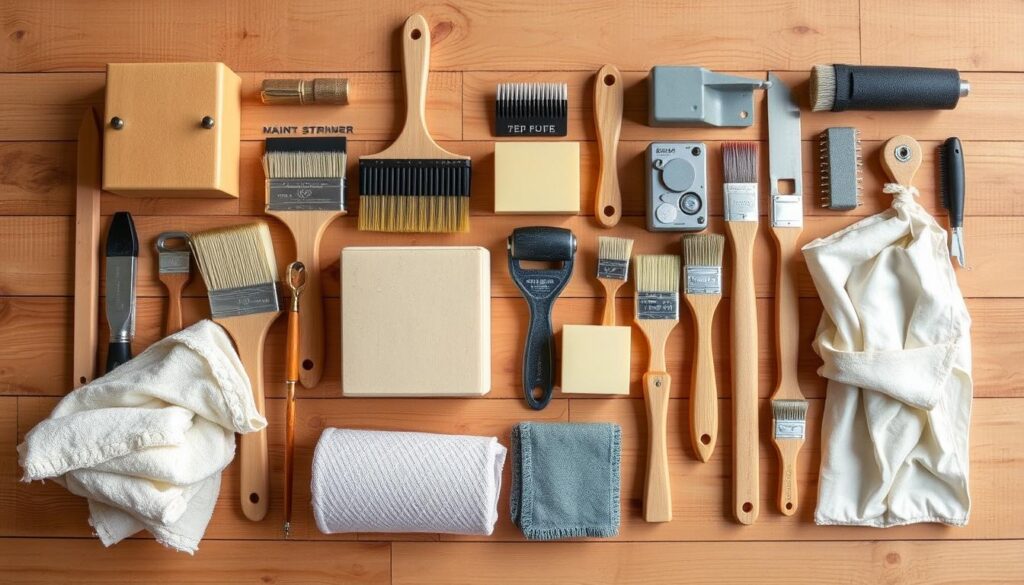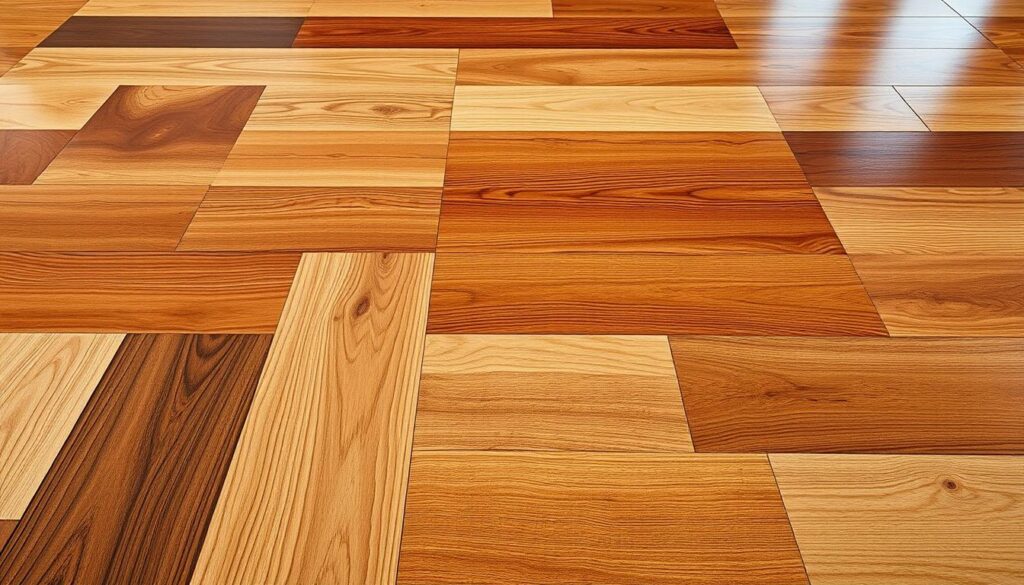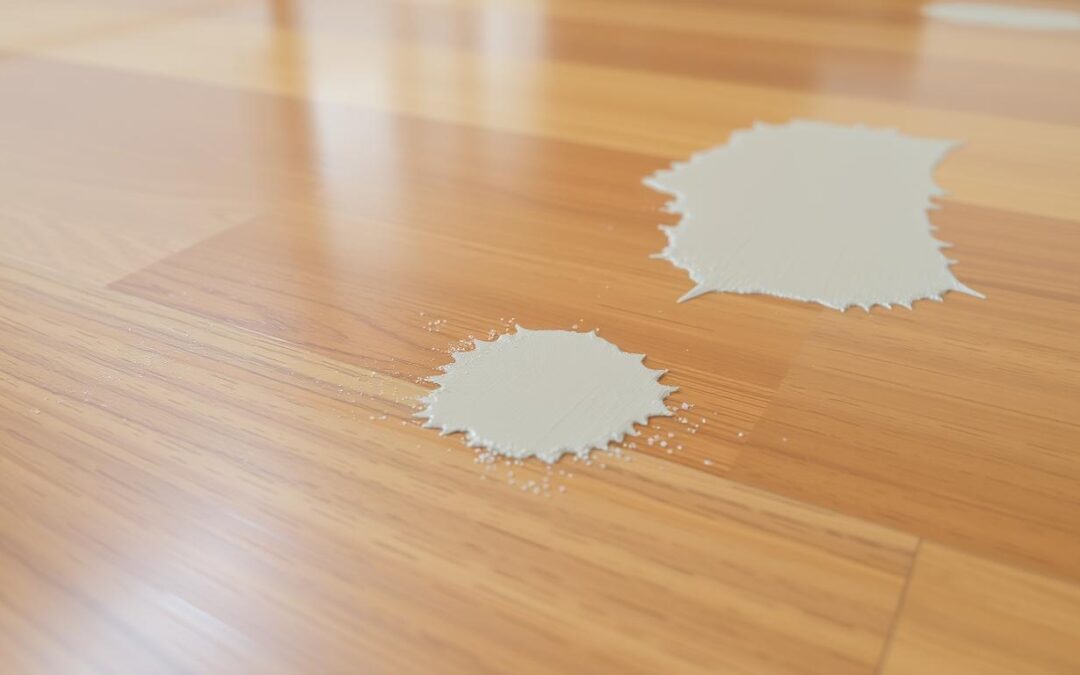Removing paint from a wood floor can be tough, especially if you want to keep the wood finish safe. You need to think about the paint type, the wood finish, and the best removal methods. Knowing about paint and finish types helps you pick the safest and most effective way.
Key Takeaways
- Properly identify the type of paint and wood finish on your floor to choose the right removal method.
- Utilize chemical-free options, such as sanding or scraping, to avoid potential damage to the wood finish.
- If using chemical paint strippers, follow safety precautions and application techniques to minimize risks.
- Properly clean and maintain the wood finish after paint removal to preserve its integrity.
- Take necessary precautions, such as proper ventilation and personal protective equipment, to ensure a safe project.
Understanding Different Types of Paint and Wood Finishes
Removing paint from wood floors requires knowing the paint and finish types. This knowledge helps you choose the best and safest removal methods. It also ensures your floor’s finish remains intact.
Common Paint Types Found on Wood Floors
Wood floors can be painted with latex, oil-based, or epoxy paints. Each type has its own removal needs. Latex paint is water-based and easier to remove. Oil-based and epoxy paints are harder to remove.
Various Wood Finishes and Their Properties
Wood floor finishes include polyurethane, varnish, lacquer, and shellac. These finishes vary in durability, sheen, and how they react to chemical strippers. Knowing these differences helps you pick the right removal method without damaging your floor.
Identifying Your Floor’s Finish Type
Before removing paint, identify your floor’s finish. You can do this by looking closely or with a simple test. Knowing the finish ensures you remove the paint safely and effectively. This way, you won’t harm the wooden finishing or polyurethane wood finish.
Learning about paint and wood finishes helps you remove paint from your how to finish wood floors successfully. You’ll get the results you want.
Essential Tools and Materials for Paint Removal
Removing paint from your wood floor requires the right tools and materials. The choice depends on the wood finish and paint type. This guide will help you pick the best items for a safe and successful process.
Mechanical Paint Removal Tools
- Scraper – A sturdy, sharp-edged tool for physically removing paint from the floor.
- Orbital sander – This power tool helps sand down paint and prepare the surface for refinishing.
- Random orbital sander – A more versatile sanding option that can tackle uneven surfaces.
- Putty knife – Useful for scraping off stubborn paint in corners and edges.
- Heat gun – Applies targeted heat to soften and lift paint, making it easier to remove.
Chemical Paint Strippers
Chemical strippers are good for delicate finishes or hard paint. Here are some popular ones:
- Methylene chloride-based strippers – Powerful but require extra caution due to toxicity.
- Soy-based strippers – Gentler, biodegradable alternatives that are safer for the user and the environment.
- Alkaline strippers – Effective on multiple paint types, but may require neutralizing after use.
Always follow the manufacturer’s instructions and safety guidelines. This ensures a safe and successful project.
| Tool or Material | Purpose | Suitable for |
|---|---|---|
| Scraper | Physically removing paint | All wood finishes and paint types |
| Orbital sander | Sanding down paint and preparing the surface | Durable wood finishes |
| Random orbital sander | Sanding uneven surfaces | Delicate wood finishes |
| Putty knife | Scraping paint from corners and edges | All wood finishes and paint types |
| Heat gun | Softening and lifting paint | Durable wood finishes |
| Methylene chloride-based stripper | Powerful paint removal | Durable wood finishes |
| Soy-based stripper | Gentle, eco-friendly paint removal | Delicate wood finishes |
| Alkaline stripper | Effective on multiple paint types | All wood finishes |

Understanding your wood floor’s needs is key to successful paint removal. Choose the right tools and materials. With the right equipment and best practices, you can restore your wood floor beautifully.
Safety Precautions and Room Preparation
Before starting to remove paint, safety and workspace preparation are key. A safe environment protects you and helps your woodwork and staining projects succeed.
Proper Ventilation Requirements
Good air flow is essential when removing paint. Open windows or use a fan to keep the air moving. This reduces the dangers from fumes and particles.
Personal Protective Equipment Needed
- Use a respirator or N95 mask to block harmful particles and vapors.
- Wear chemical-resistant gloves to protect your hands.
- Protect your eyes with goggles to avoid splashes or debris.
- Wear long sleeves and pants to keep your skin safe from chemicals.
Surface Protection Methods
- Use plastic sheeting or drop cloths to cover nearby areas, furniture, or fixtures.
- Seal vents, doors, and openings to keep the area contained.
- Place cardboard or plywood on floors to protect them.
By carefully following these steps, you’ll have a safe space for your woodwork and staining projects. This ensures a safe and effective paint removal process.

| Safety Measure | Importance |
|---|---|
| Proper Ventilation | Reduces exposure to harmful fumes and particles |
| Personal Protective Equipment | Safeguards eyes, skin, and respiratory system |
| Surface Protection | Prevents the spread of paint stripper and debris |
“Take the necessary precautions to ensure a safe and successful paint removal process for your woodwork finishes and how to stain and finish wood projects.”
Chemical-Free Methods to Remove Paint from a Wood Floor
If you want to remove paint from your wood floors without harsh chemicals, there are good options. These chemical-free methods can bring back your wood finishes‘ natural beauty. They also keep your home and the environment safe.
Sanding to the Rescue
Sanding is a top choice for removing paint from wood floors. Begin with coarse grit sandpaper to get rid of most paint. Then, switch to finer grits to make the surface smooth. Always sand in the wood grain direction to protect the wood finishes.
The Scraping Technique
If sanding doesn’t work, try a scraping tool. Scrape the paint in the wood grain direction, but be careful not to scratch the wood finishes. This method is best for small paint spots.
Heat Application: A Careful Approach
Heat can also help remove paint. Use a heat gun or sharp scraper to warm the paint and make it easier to remove. But, be careful not to damage the wood finishes with too much heat.
When picking a chemical-free method, think about the paint type, wood finishes condition, and your comfort with the technique. Understanding these factors helps you safely and effectively restore your wood floors without harsh chemicals.
Using Chemical Paint Strippers Safely and Effectively
Chemical paint strippers can be very effective for removing paint from wood floors. But, it’s important to know the right techniques and safety steps for a good result.
Types of Chemical Strippers
There are many types of chemical paint strippers out there. Each one works differently and is suited for various needs. Here are a few common ones:
- Solvent-based strippers: These use strong solvents to break down and remove paint layers.
- Methylene chloride-based strippers: These are very effective but need extra care because they can be dangerous.
- Soy-based strippers: These are a greener option, using natural solvents to remove paint.
When picking a chemical stripper, think about the paint on your floors and the wood’s condition. Talking to a pro or testing a small area can help you choose the best one.
Application Techniques
How you apply the stripper is key to getting good results. Always follow the instructions and work in small areas for even coverage. Use a brush or roller, let it sit as directed, then scrape or wipe off the paint.
Neutralizing After Stripping
After removing the paint, it’s important to neutralize the wood. This stops any leftover chemicals from messing with your new polyurethane wood finish. Rinse the floor well with water or a neutral solution, then dry it completely.
Knowing about different chemical strippers, using them right, and neutralizing the wood can help you remove paint safely. This way, you won’t harm the wood finishing materials or the new polyurethane wood finish you’re going to put on.
Spot Treatment Techniques for Small Paint Spills
Removing unwanted paint from your wood floor quickly is key. It helps prevent damage to the surface finish. For small spills or splatters, you need a gentle approach. Here are some spot treatment methods to restore your wood floor’s beauty.
Gentle Scraping with a Plastic Scraper
Using a plastic scraper is a simple yet effective way to handle small paint spills. Gently run the scraper over the area, without applying too much pressure. This method lifts and removes paint without harming the wood finish.
Mineral Spirits for Stubborn Spots
For harder paint stains, try mineral spirits. Dampen a cloth with the solvent and gently dab the area. Be careful not to soak the wood finish. Clean the area with a fresh cloth once the paint is gone.
Specialized Wood Floor Cleaners
For a targeted solution, use a wood floor cleaner made for paint splatters. These cleaners break down paint without damaging the wood finish. Always read the instructions and test it on a small area first.
When working on how to do wood finishing, be patient and gentle. Avoid scrubbing or using too much force. This way, you can keep your floors looking beautiful and durable.
Maintaining Your Wood Finish After Paint Removal
After removing unwanted paint from your wood floor, it’s key to keep the finish in good shape. This ensures the wood’s natural beauty lasts for years. By following a few easy steps, your floor will stay beautiful for a long time.
Post-Removal Cleaning Methods
Begin by cleaning the floor well to get rid of leftover paint or stripper. Use a gentle, wood-safe cleaner and a soft-bristle brush to clean. Don’t use harsh abrasives, as they can harm the finish. Make sure the floor is dry before moving on.
Finish Touch-Up Techniques
Look for small scratches, dings, or worn spots on the floor. Fix these with a bit of wood finish, like polyurethane or lacquer. Follow the maker’s instructions to match the finish. For bigger damage, you might need a pro to refinish it.
Preventive Care Tips
To keep your wood floor looking great, clean and maintain it regularly. Place rugs or mats in busy spots to protect the floor. Also, avoid dragging heavy furniture and clean spills quickly to prevent damage.
FAQ
What is the best way to remove paint from a wood floor without damaging the finish?
To remove paint from a wood floor, you need to know the paint type and the wood finish. Check your floor’s finish and use the right removal methods. This way, you won’t harm the wood.
How do I determine the type of paint and wood finish on my floor?
Inspect your floor closely to find labels or tags. These can tell you about the paint and wood finish. You can also test a small area with paint thinner or mineral spirits. If it dissolves, it’s oil-based paint. If not, it’s latex.
For the wood finish, you might need to ask a professional or do more research. This will help you identify the specific type.
What are the essential tools and materials needed for safe paint removal from a wood floor?
You’ll need tools like scrapers, sandpaper, and a heat gun. Chemical paint strippers, mineral spirits, rags, and PPE are also important. The tools you need will depend on the paint and wood finish.
How can I safely prepare the room and protect the surrounding areas during paint removal?
Make sure the room is well-ventilated and cover furniture and walls with drop cloths or plastic sheeting. Wear goggles, gloves, and a respirator. Dispose of paint debris and chemical waste safely.
What are some chemical-free methods for removing paint from a wood floor?
Sanding, scraping, and using a heat gun are good chemical-free methods. Sanding can be done with a floor sander or palm sander. Scraping and heat application need care to avoid damage. These methods work well for softer paints or when the finish is good.
How can I use chemical paint strippers effectively and safely?
Choose the right chemical paint stripper for your paint type and follow the instructions. Apply the stripper, let it work, then scrape off the paint. Clean and neutralize the wood to prevent damage.
How can I address small paint spills or splatters on my wood floor?
For small spills, use a plastic scraper to remove paint. Then, apply mineral spirits or a wood floor cleaner. Gently blot and wipe to remove paint without harming the finish.
How do I maintain the wood finish after removing paint from my floor?
Clean the floor well after removing paint. Check the wood finish and fix any damage. Apply a new wood finish, like polyurethane or varnish, to protect the wood. Clean and reapply the finish as needed.

